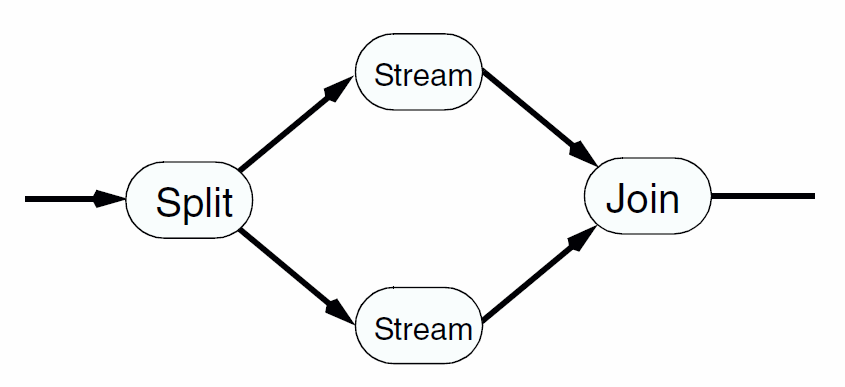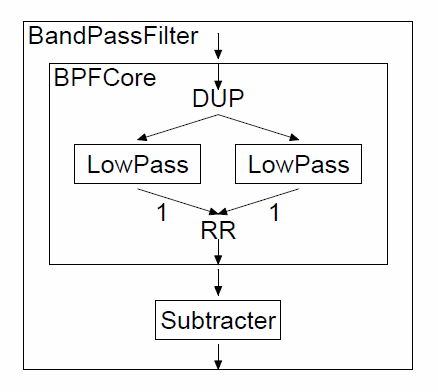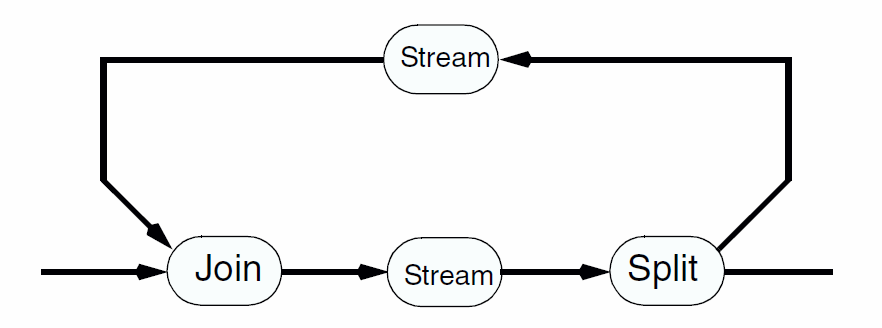-
W. Thies, M. Karczmarek, and S. Amarasinghe, “StreamIt: A Language for Streaming Applications,” in Compiler Construction, 2002, pp. 179–196.
-
MIT, StreamIt Cookbook. 2006.
Motivation for StreamIt
-
Provide high-level stream abstractions to improve productivity and program robustness within streaming domain
-
Serve as common machine language for grid-based processors [1]
Characteristics of a Streaming Application
-
Large (virtually infinite) streams of data
-
Independent filters as basic unit of transformation
-
Stable computation pattern
-
Occasional structure modification and side-effects
-
e.g. adding filters to clean up high noise; changing cell phone volume
-
-
High performance
Program Structure
A program is a composition (via pipelines, split-joins, and feedback loops) of filters into a directed stream graph, connecting inputs to outputs.
Filter
void->int filter IntSource { (1)
int x;
init { x = 0; } (2)
work push 1 { push(x++); } (3)
}| 1 | Specify input and output types; void indicates a boundary of program |
| 2 | Establishes initial state; will be called implicitly with same arguments passed to constructor |
| 3 | Execution step in steady state; push adds a single item to filter’s output stream |
Pipeline

void->void pipeline MovingAverage {
add IntSource(); (1)
add Averager(10);
add IntPrinter();
}
int->int filter Averager(int n) {
work pop 1 push 1 peek n { (2)
int sum = 0;
for (int i = 0; i < n; i++)
sum += peek(i); (3)
push(sum/n);
pop(); (4)
}
}
void->int filter IntSource {
int x;
init { x = 0; }
work push 1 {
push(x);
x++;
}
}
int->void filter IntPrinter {
work pop 1 { println(pop()); }
}| 1 | Add filters (connected in order) |
| 2 | Specify data rates; peek(n) is a maximum rate |
| 3 | peek(0) returns next item that would be popped |
| 4 | pop removes a single item from the its input stream |
Here’s what it looks like from a higher-level: 
|
The scheduler guarantees that |
Split Join

float->float pipeline BandPassFilter (float rate, float low, float high, int taps) {
add BPFCore(rate, low, high, taps);
add Subtracter();
}
float->float splitjoin BPFCore (float rate, float low, float high, int taps) {
split duplicate; (1)
add LowPassFilter(rate, low, taps, 0);
add LowPassFilter(rate, high, taps, 0);
join roundrobin; (2)
}
float->float filter Subtracter {
work pop 2 push 1 {
push(peek(1) - peek(0));
pop(); pop();
}
}| 1 | Splitter runs some number of children in parallel |
| 2 | Round-robin joiner combines outputs from children in order they were added |
Here’s what it looks like from a higher-level: 
|
Round-robin can be used as both a splitter and joiner.
In the joiner case, |
Feedback Loop

-
Can consider this an inverted split-join (joiner at the top and splitter at the bottom).
-
Has exactly two children ("body" and "loop")
float->float feedbackloop Echo
(int n, float f) {
join roundrobin(1,1);
body FloatAdderBypass(); (1)
loop float->float filter { (2)
work pop 1 push 1 {
push(pop() * f);
}
};
split roundrobin;
for (int i = 0; i < n; i++)
enqueue(0); (3)
}
float->float filter FloatAdderBypass {
work pop 2 push 2 {
push(peek(0) + peek(1));
push(peek(0));
pop();
pop();
}
}| 1 | Adds child as body part of feedback loop |
| 2 | Adds child as loop part of feedback loop |
| 3 | Pushes item onto input of joiner coming from loop part of feedback loop |
Here’s what it looks like from a higher-level: 
Miscellanea
-
Data rates can be dynamically or statically allocated
-
Only datatypes are void, int, float, complex, and bit